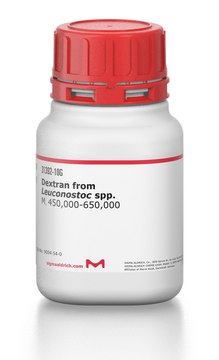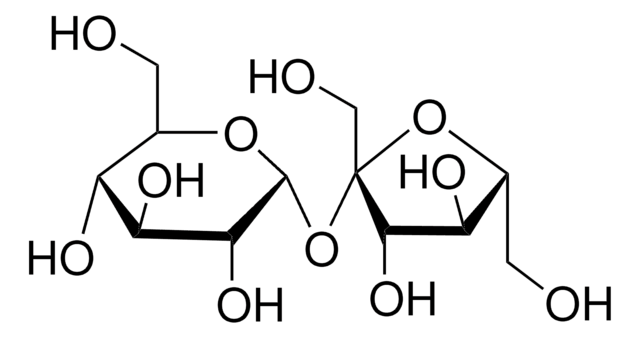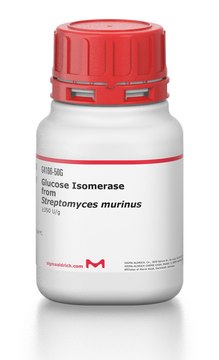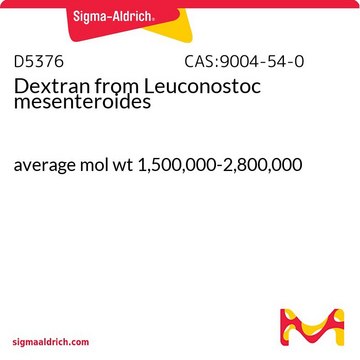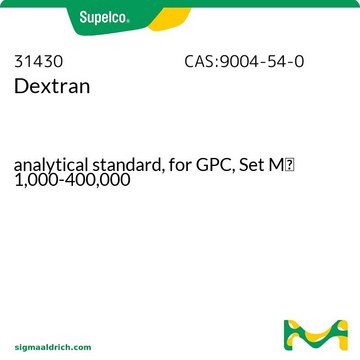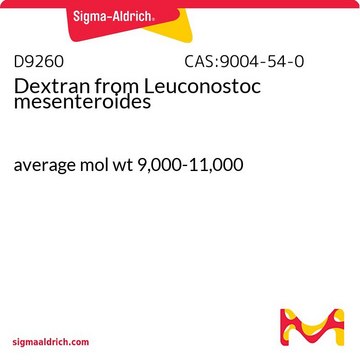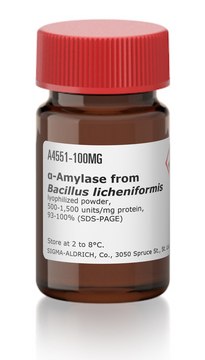D9909
Dextran Sucrase from Leuconostoc mesenteroides
lyophilized powder, ≥100 units/mg protein
Sign Into View Organizational & Contract Pricing
All Photos(2)
About This Item
CAS Number:
MDL number:
UNSPSC Code:
12352204
NACRES:
NA.54
Recommended Products
biological source
bacterial (Leuconostoc mesenteroides)
Quality Level
form
lyophilized powder
specific activity
≥100 units/mg protein
composition
Protein, ~15% Lowry
solubility
H2O: soluble 0.9-1.1 mg/mL, clear to slightly hazy, colorless to light yellow
storage temp.
−20°C
General description
Dextran Sucrase from Leuconostoc mesenteroides belongs to glycoside hydrolase family 70 (GH70). It functions through a retaining mechanism and uses two catalytic acidic residues. Dextran sucrase has a dextran binding site in the C-terminal domain.
Application
Dextran Sucrase from Leuconostoc mesenteroides has been used:
- in immobilization on shirasu porous membrane (SPG) for dextran production
- in the enzymatic synthesis of dextran nanoparticles at various pH range
- in the immobilization with hydroxyapatite for dextran production
Dextran sucrase from Leuconostoc mesenteroides has been used in a study to investigate the functional and structural characterization of α-(1→2) branching sucrase derived from DSR-E glucansucrase. Dextran sucrase from Leuconostoc mesenteroides has also been used in a study to investigate the bioengineering of Leuconostoc mesenteroides glucansucrases.
The enzyme from Sigma has been used to prepare immobilized sphere for the production of dextran from sucrose.
Biochem/physiol Actions
Dextransucrases are glucansucrases that are able to produce dextran, a glucose polymer linked mainly through α1-6 bonds. However, α1-3, α1-6, α1-4 and α1-2 bonds are also found, in both the main chain and the branching linkages. The peptide has approximately 1600 amino acids. The aspartic acid in position 551 is essential for catalytic activity, while glutamic acid 589 and aspartic acid 662 complement the catalytic triad. The activity of dextransucrase is decreased by EDTA, and is restored by the addition of calcium ions. Zinc, cadmium, lead, mercury and copper ions are inhibitory to various degrees.
Quality
Chromatographically purified
Unit Definition
One unit will liberate 1.0 μmole of fructose per min at 37 °C, pH 5.4.
Physical form
Lyophilized powder containing dextran, MES buffer salts and CaCl2
Storage Class Code
11 - Combustible Solids
WGK
WGK 3
Flash Point(F)
Not applicable
Flash Point(C)
Not applicable
Personal Protective Equipment
dust mask type N95 (US), Eyeshields, Gloves
Regulatory Information
新产品
Choose from one of the most recent versions:
Certificates of Analysis (COA)
Lot/Batch Number
Don't see the Right Version?
If you require a particular version, you can look up a specific certificate by the Lot or Batch number.
Already Own This Product?
Find documentation for the products that you have recently purchased in the Document Library.
Bioengineering of Leuconostoc mesenteroides glucansucrases that gives selected bond formation for glucan synthesis and/or acceptor-product synt
Kang, H., et al.
RNA, 59, 4148-4155 (2011)
Enzymatically synthesized dextran nanoparticles and their use as carriers for nutraceuticals
Semyonov D, et al.
Food & Function, 5(10), 2463-2474 (2014)
Marie-Sophie Bounaix et al.
FEMS microbiology letters, 311(1), 18-26 (2010-08-21)
The study of exopolysaccharide production by heterofermentative sourdough lactic acid bacteria has shown that Weissella strains isolated from sourdoughs produce linear dextrans containing α-(1→6) glucose residues with few α-(1→3) linkages from sucrose. In this study, several dextran-producing strains, Weissella cibaria
Hidetaka Kawakita et al.
Journal of chromatography. B, Analytical technologies in the biomedical and life sciences, 877(3), 347-350 (2009-01-03)
Dextransucrase forms a complex with dextran during an enzymatic reaction with sucrose. Using its enzymatic character, we performed a continuous and dynamic rejection of colloidal particles by generating dextran with dextransucrase immobilized in an inorganic porous membrane. Inorganic membranes having
Surface Modification of Hydrophobic Sphere with Dextran Generated from Enzymatic Reaction for Adsorption Site.
Nagata, Daiki, et al.
Advanced Chemical Engineering Research, 2(1), 20-25 (2013)
Our team of scientists has experience in all areas of research including Life Science, Material Science, Chemical Synthesis, Chromatography, Analytical and many others.
Contact Technical Service
